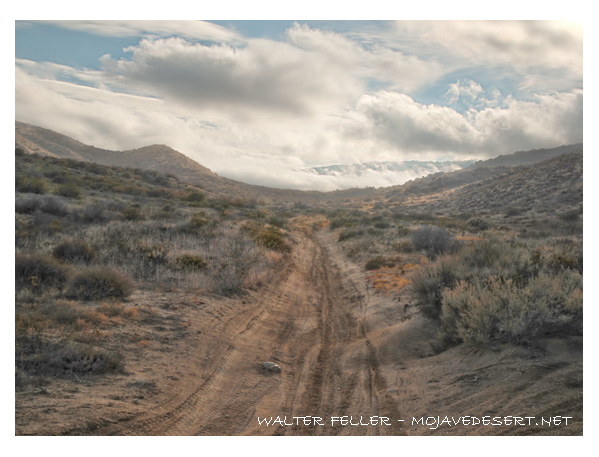Victor Valley - Historic Portal
The Road Builders: 1850-1885

When California became a state in the year 1850, San Bernardino County and everything from Santa Barbara to San Diego was part of Los Angeles County. The second year of the Gold Rush saw a census count of only 1,610 persons (Indians excluded) living in this area of 34,000 square miles. Jefferson Hunt's wagon train had increased the population by more than a third as it crossed out of Nevada Territory, and the demand for beef in the Mother Lode was creating real fortunes, but neither situation described anything like a "boom." If any existed in the region, it was the dramatic increase in gamblers and killers drifting south from the mines to the village of Los Angeles, the county seat and the toughest town in the United States.
In 1853, the year San Bernardino's settlers petitioned to create a separate county, the job of Sheriff went begging in Los Angeles at $10,000 per year, and the pueblo boasted more murders (Indians and Mexicans not counted) than half the states of the Union combined! Little wonder that the solid, industrious citizens of San Bernardino voted for home rule!
Over the next six years steady if undramatic progress marked the growth of the valleys joined at Cajon Pass. A sawmill to serve the area was built in the mountains near Crestline in 1853, others followed to provide lumber needed to build homes for the settlers. Most important, before 1855 a Captain Sanford had managed to build a graded road up the rugged south face of the Pass, making it possible to freight wagon loads of supplies and equipment from Wilmington and San Pedro harbors to the Eastern Sierra slopes, Nevada mining camps and even Salt Lake City. Other immigrant trains could now travel the winter route to California without the hardships of the first pioneers, and the sprawling Verde, Las Flores, and Swarthout & Reche cattle ranches in the Victor Valley were now within two or three days ride of the harbors.
In November, 1857 Lt. Edward Fitzgerald Beale, USN, formerly Indian Affairs agent for California and Nevada, treated the Mojave River crossing north of Victorville to a spectacle never seen before . . . or since. The entire U.S. Camel Corps of which Beale was commandant paraded through the yucca and Joshua trees reroute to his base at Ft. Tejon, and Drum Barracks in Wilmington. Purchased in Turkey, the dromedaries were used for army freight and road building work until 1866. The camel experiment was abandoned because of the reaction they caused among other dray animals. History does not record the initial reaction of the primitive Mohave to the sight of 77 camels being herded westward along the banks of their ancestral river.
Fate took a hand in the steady growth of the area in 1860 when William Holcomb of San Bernardino hit gold near Big Bear Lake. The boom that followed saw the creation of the town of Belleville in the mountains and the building of additional roads from the Victor Valley side of Cajon southward. Traces of Brown's Toll Road and Van Deuzen's Toll Road remain today to remind of 16-mule teams straining in and out of the canyons. For thirty-five years everything dug out of the desert, and the shovel used to dig it with, was carried across the sands and over the rocks in mule or ox drawn wagons.
The fame of Holcomb's and later, "Lucky" Baldwin's mines at Big Bear attracted prospectors to the desert by the thousands, increasing the need for freight roads as claims were worked and sometimes developed into mining towns. During the Civil War years, a devastating drought struck Southern California, destroying thousands of head of cattle, disrupting the economy and turning ranch hands into prospectors and teamsters as well. Shorter routes between points along the Mojave/Spanish/Mormon trail system were developed wherever the presence of water permitted, such as Stoddard Wells Road connecting Huntington Station (Victorville)* with Fish Ponds (near Barstow).
Finally, the railroad came to Victor Valley. An engineering triumph, the first track climbed and wound over Cajon Pass from San Bernardino, arriving in 1883. Built by the California Southern RR (later AT&SF) under the supervision of L. N. Victor, the line reached the Atlantic & Pacific (UPRR) junction at Barstow/Daggett in 1885. Thereafter, numerous mining tracks and shortline roads were built to carry ore and sometimes passengers throughout the Mojave. Some of these included: Bullfrog & Goldfield RR, Death Valley RR and Tecopa RR all absorbed into the Tonapah & Tidewater; the Daggett & Borate; and the Randsburg Rwy. Co. (which never served Randsburg). All of the above have been abandoned or merged with either Santa Fe or Union Pacific.
For the next 35 years, nearly everything that wasn't carried in a wagon was carried on the train. Then, in 1923 the road crossing the Pass was paved for the first time. But that's another story.
< previous - next >